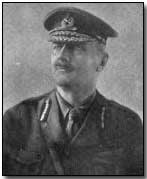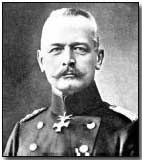Battles - The Third Battle of Gaza, 1917
 With Edmund
Allenby's appointment to command of the Egyptian Expeditionary Force in
the wake of two failed attacks at Gaza in
March and
April 1917 - replacing
Sir Archibald Murray who was recalled to London - he was tasked by
British Prime Minister
David Lloyd George with the capture of Jerusalem by
Christmas 1917.
With Edmund
Allenby's appointment to command of the Egyptian Expeditionary Force in
the wake of two failed attacks at Gaza in
March and
April 1917 - replacing
Sir Archibald Murray who was recalled to London - he was tasked by
British Prime Minister
David Lloyd George with the capture of Jerusalem by
Christmas 1917.
In the light of the British army's two recent failures it appeared a tall order in spite of clear British numerical supremacy in the area. Allenby nevertheless delivered Jerusalem to London handily in time for Christmas with over two weeks to spare.
In order to ensure the fall of Jerusalem however Allenby needed first to break the Turkish line at Gaza-Beersheba overseen by recently arrived German commander Erich von Falkenhayn, the former army Chief of Staff.
Allenby opened preparations by first relocating his GHQ from a first-class Cairo hotel to the front line; a symbolic act designed to boost the flagging morale of the British troops. Next he amassed reinforcements of men, artillery, gas shells and tanks, adamant that he would not proceed until certain of victory. Seven infantry divisions plus a Light Horse unit (nicknamed the Desert Mounted Corps and consisting of both horses and camels) were assembled, a total of 88,000 men.
Ranged against him were the Turkish Seventh and Eighth Armies, totalling just 35,000 men stretched out along a 40km line. A key component of Allenby's plan was the securing of Beersheba's water supplies at an early stage during the planned attack - its wells.
Both earlier attacks at Gaza had to some extent foundered on account of water shortages - an ever-present concern in desert warfare - and Allenby understood that establishing command of water supplies would be a key factor in his wider plan of capturing Jerusalem.
Thus the Third Battle of Gaza - also referred to as the Battle of Beersheba - was initiated early on the morning of 31 October 1917. Not for Allenby a frontal attack, as at the Second Battle of Gaza. Instead he resolved to take the Turkish forces by surprise in the relatively lightly defended area of Beersheba (a plan initially proposed by General Chetwode), deploying 40,000 troops in the area.
 He
nevertheless ensured a hefty British presence directly in front of Gaza. Three divisions, aided by a
heavy artillery presence of 218 guns, bombarded the garrison for six days
before the attack began in order to fool the Turks into believing that a
full frontal attack was imminent.
He
nevertheless ensured a hefty British presence directly in front of Gaza. Three divisions, aided by a
heavy artillery presence of 218 guns, bombarded the garrison for six days
before the attack began in order to fool the Turks into believing that a
full frontal attack was imminent.
Allenby's ploy, which demanded the utmost secrecy in planning, succeeded in its entirety. British RFC aircraft - of newly deployed Bristol fighters - ensured British air superiority, crucial in preventing German aircraft from detecting British troop movements.
Allenby deployed infantry forces to take Beersheba from the front while despatching his Light Horse unit far to the east. Following an all-day battle an Australian Light Horse unit finally penetrated the Turkish defences and secured control over the town's wells before the Turks could execute a prepared plan to contaminate them.
The Turkish Seventh Army meanwhile retired to the stronghold of Tel es Sheria commanded by German commander Kress von Kressenstein's Eighth Army. Panicked there by another diversionary attack to the east by a 70-strong camel company, the Turkish defenders began to scatter believing it to be a large-scale flank attack, thus leaving the flank of Seventh Army exposed.
Promptly exploiting this Allenby struck north at Tel es Sheria at dawn on 6 November splitting Seventh and Eighth Armies. Allenby hoped to trap Kressenstein's Eighth Army at Gaza but the Turks retreated in some haste further up the coast, Gaza being abandoned on 6-7 November. Meanwhile Eighth Army established itself in Jerusalem preparatory to a stand against the British.
Having concluded the successful capture of Gaza Allenby next turned his attention to the fall of Jerusalem, which he succeeded in securing the following month.
To view maps charting the course of the three Gaza battles click here; and here; and here.
Photographs courtesy of Photos of the Great War website
"Harry Tate" was the nickname given by British pilots to the R.E.8 aircraft
- Did you know?
